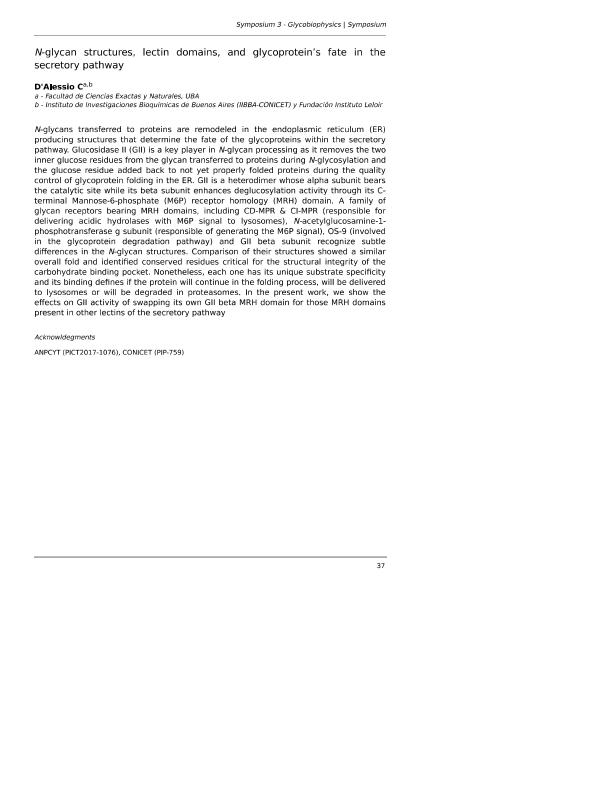Mostrar el registro sencillo del ítem
dc.contributor.author
D'alessio, Cecilia

dc.contributor.other
Andujar, Sebastian Antonio

dc.date.available
2022-10-24T12:29:20Z
dc.date.issued
2019
dc.identifier.citation
N-glycan structures, lectin domains, and glycoprotein’s fate in the secretory pathway; XLVIII Reunión Anual de la Sociedad Argentina de Biofísica; San Luis; Argentina; 2019; 1-1
dc.identifier.isbn
978-987-27591-7-9
dc.identifier.uri
http://hdl.handle.net/11336/174497
dc.description.abstract
N-glycans transferred to proteins are remodeled in the endoplasmic reticulum (ER) producing structures that determine the fate of the glycoproteins within the secretory pathway. Glucosidase II (GII) is a key player in N-glycan processing as it removes the two inner glucose residues from the glycan transferred to proteins during N-glycosylation and the glucose residue added back to not yet properly folded proteins during the quality control of glycoprotein folding in the ER. GII is a heterodimer whose alpha subunit bears the catalytic site while its beta subunit enhances deglucosylation activity through its Cterminal Mannose-6-phosphate (M6P) receptor homology (MRH) domain. A family of glycan receptors bearing MRH domains, including CD-MPR & CI-MPR (responsible for delivering acidic hydrolases with M6P signal to lysosomes), N-acetylglucosamine-1- phosphotransferase g subunit (responsible of generating the M6P signal), OS-9 (involved in the glycoprotein degradation pathway) and GII beta subunit recognize subtle differences in the N-glycan structures. Comparison of their structures showed a similar overall fold and identified conserved residues critical for the structural integrity of the carbohydrate binding pocket. Nonetheless, each one has its unique substrate specificity and its binding defines if the protein will continue in the folding process, will be delivered to lysosomes or will be degraded in proteasomes. In the present work, we show the
effects on GII activity of swapping its own GII beta MRH domain for those MRH domains present in other lectins of the secretory pathway.
dc.format
application/pdf
dc.language.iso
spa
dc.publisher
Sociedad Argentina de Biofísica
dc.rights
info:eu-repo/semantics/openAccess
dc.rights.uri
https://creativecommons.org/licenses/by-nc-sa/2.5/ar/
dc.subject
Glycosylation
dc.subject
MRH domain
dc.subject
secretory pathway
dc.subject
yeast
dc.subject.classification
Bioquímica y Biología Molecular

dc.subject.classification
Ciencias Biológicas

dc.subject.classification
CIENCIAS NATURALES Y EXACTAS

dc.title
N-glycan structures, lectin domains, and glycoprotein’s fate in the secretory pathway
dc.type
info:eu-repo/semantics/publishedVersion
dc.type
info:eu-repo/semantics/conferenceObject
dc.type
info:ar-repo/semantics/documento de conferencia
dc.date.updated
2022-03-16T20:34:49Z
dc.journal.pagination
1-1
dc.journal.pais
Argentina

dc.journal.ciudad
San Luis
dc.description.fil
Fil: D'alessio, Cecilia. Consejo Nacional de Investigaciones Científicas y Técnicas. Oficina de Coordinación Administrativa Parque Centenario. Instituto de Investigaciones Bioquímicas de Buenos Aires. Fundación Instituto Leloir. Instituto de Investigaciones Bioquímicas de Buenos Aires; Argentina
dc.relation.alternativeid
info:eu-repo/semantics/altIdentifier/url/https://biofisica.org.ar/reuniones-cientificas/reunionsab-previas/
dc.conicet.rol
Autor

dc.coverage
Nacional
dc.type.subtype
Reunión
dc.description.nombreEvento
XLVIII Reunión Anual de la Sociedad Argentina de Biofísica
dc.date.evento
2019-11-27
dc.description.ciudadEvento
San Luis
dc.description.paisEvento
Argentina

dc.type.publicacion
Book
dc.description.institucionOrganizadora
Sociedad Argentina de Biofísica
dc.description.institucionOrganizadora
Universidad Nacional de San Luis
dc.source.libro
XLVIII Reunión Anual de la Sociedad Argentina de Biofísica: Libro de resúmenes
dc.source.revista
Acta de congreso de XLVIII Reunión Anual de la SAB
dc.date.eventoHasta
2019-11-29
dc.type
Reunión
Archivos asociados
